This document presents a method for liver segmentation using a 2D U-Net model. The method first preprocesses CT scan images using techniques like windowing, masking, normalization, and morphological operations. It then trains a 2D U-Net model on slices containing liver regions only, in order to focus modeling on liver segmentation. To improve inference performance on full volumes which may contain non-liver slices, the method uses histogram analysis to roughly select a range of slices likely to contain liver, such as the central 40% of slices. Evaluation shows this rough selection approach improves segmentation accuracy compared to applying the model to full volumes directly.
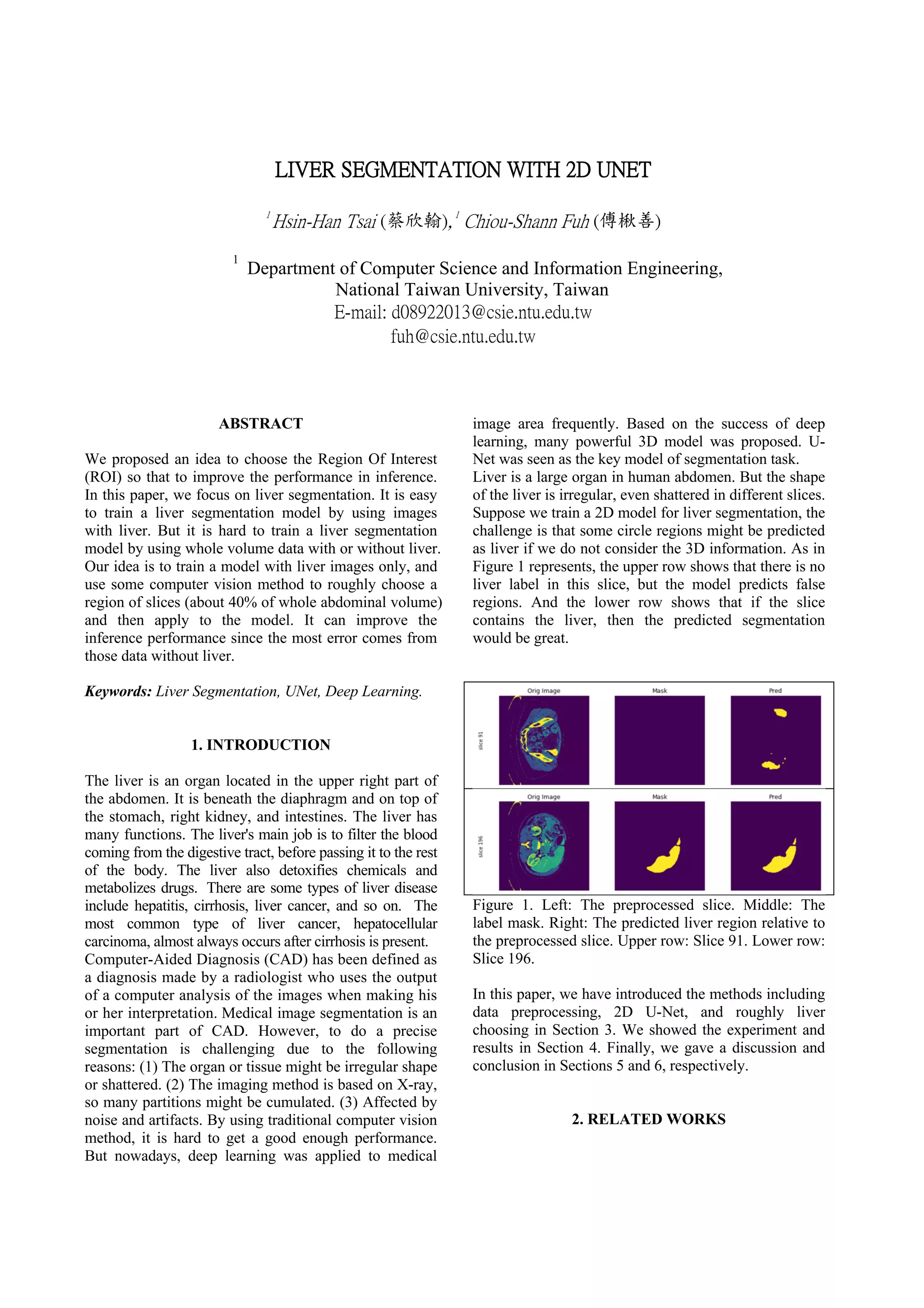
![Liver segmentation task has been researched for a long
time. There were many challenges from many
conferences in the world. The famous one, MICCAI
2017 challenge [1], encourages researchers to develop
automatic segmentation algorithms to segment liver
lesions in contrast-enhanced abdominal CT scans. There
are several state-of-the-art algorithms from worldwide
researchers. The algorithms can be categorized into
several classes, deep learning 3D based [2, 3, 4, 5], deep
learning 2D based [6, 7, 8], statistical based [9, 10],
computer vision based [11]. In general, deep learning
3D based method performs better. But the trade of is
that the computations is much higher than deep learning
2D based method. For us, we still want to apply deep
learning 2D based method and combine with statistical
or computer vision methods to keep training fast and get
similar performance to deep learning 3D based method.
3. METHOD
3.1. Data Preprocessing
Computed Tomography (CT) is often used to refer to X-
ray because of the similar imaging principle. The unit in
the CT image is called Hounsfield Unit (HU) or CT
number. Hounsfield unit scale is a linear transformation
of the linear attenuation coefficients of water and air.
The HU value of liver is around 60, so it gives us a clue
for image preprocessing.
3.1.1. Windowing
Windowing is a common preprocessing method in CT
images. The effect of windowing is contrast
enhancement. The brightness of the image is adjusted by
the Window Level (WL). The contrast is adjusted by the
Window Width (WW). The window level is the
midpoint of the HU values range displayed. The
window width is the range of CT numbers that an image
contains. According to biochemistry knowledge, the HU
value of the liver is around 60. For our experiments, we
chose WL = 90 and WW = 220 to include the liver.
After image windowing, the HU values lower than -20
will be set to -20 and the HU values higher than 200
will be set to 200. The example before and after image
windowing is shown in Figure 2.
(a) Without windowing (b) Windowing
Figure 2. Before and after the image windowing. (a)
Original CT image. (b) Image windowing with WL = 90
and WW = 220.
3.1.2 Masking
To discard some image values which are higher than the
window range. Since they displayed other organs or
tissues. For our experiment, we set the CT numbers over
200 as -20. Figure 3 shows the result before and after
masking.
(a) Before masking (b) After masking
Figure 3. Remove the pixels whose CT number exceeds
200. (a) Image after windowing but before masking. (b)
Masking result of image (a).
3.1.3 Normalization
The minimum maximum normalization has been chosen.
The formula is described as follows
3.1.4 Opening
Opening is an important operator from mathematical
morphology. In simple, an opening operator is defined
as an erosion followed by a dilation using the same
structuring element. The effect of an opening operator is
to preserve foreground regions that have a similar shape
to the structure element. Figure 4 shows the image
before and after an opening operator with a 3*3
structuring element.
(a) Before opening (b) After opening
Figure 4. To show the effect of o an opening operator. (a)
Image in Figure 3(b). (b) Image (a) after opening
operation. As we can see the bed is removed.
3.1.5 Closing
Closing is an operator defined as a dilation followed by
an erosion using the same structuring element. It is a
dual operator of opening. The effect of closing is to
preserve background regions that have a similar shape](https://image.slidesharecdn.com/liversegmentationwith2dunet-211007122243/75/Liver-segmentationwith2du-net-2-2048.jpg)
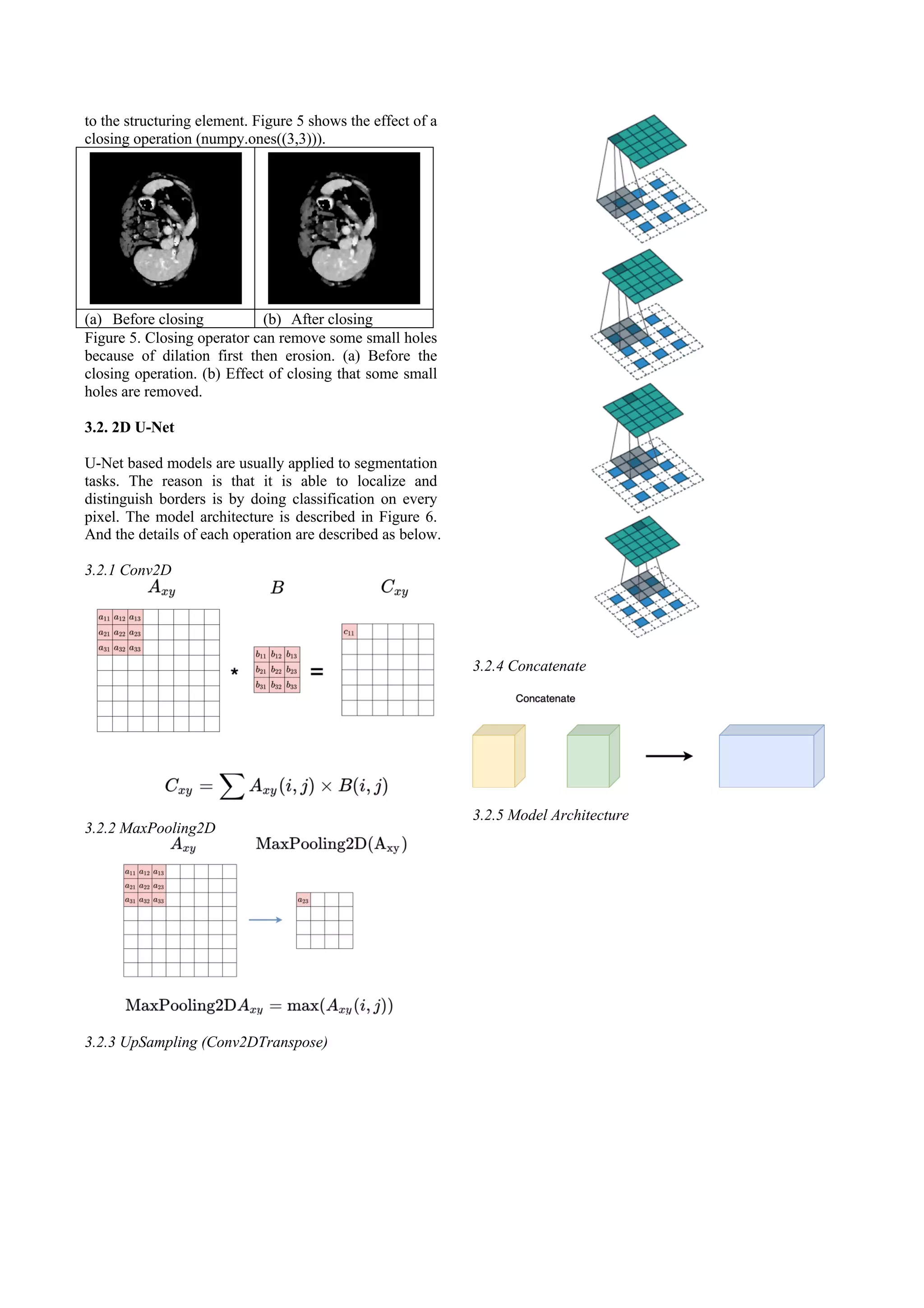
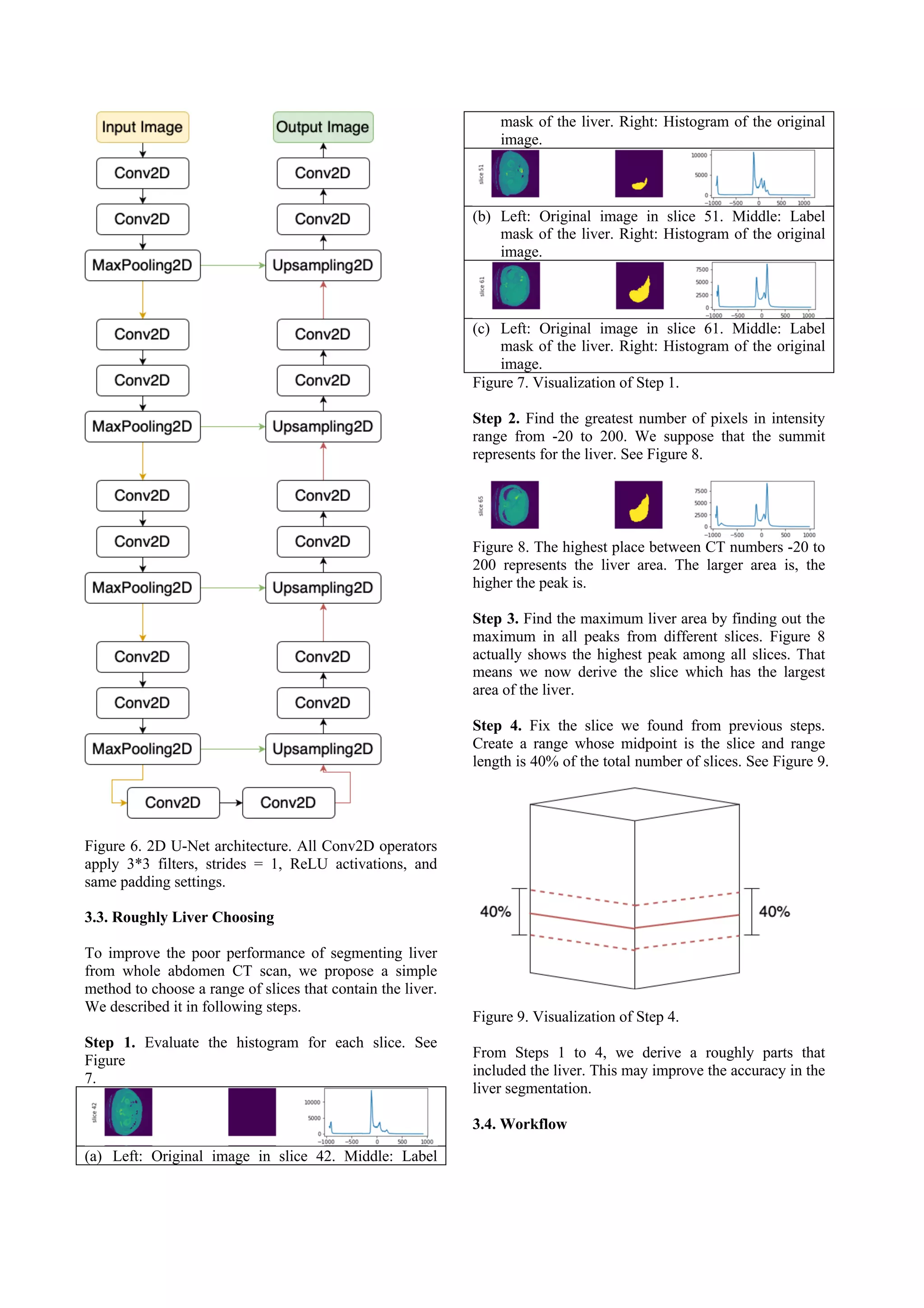
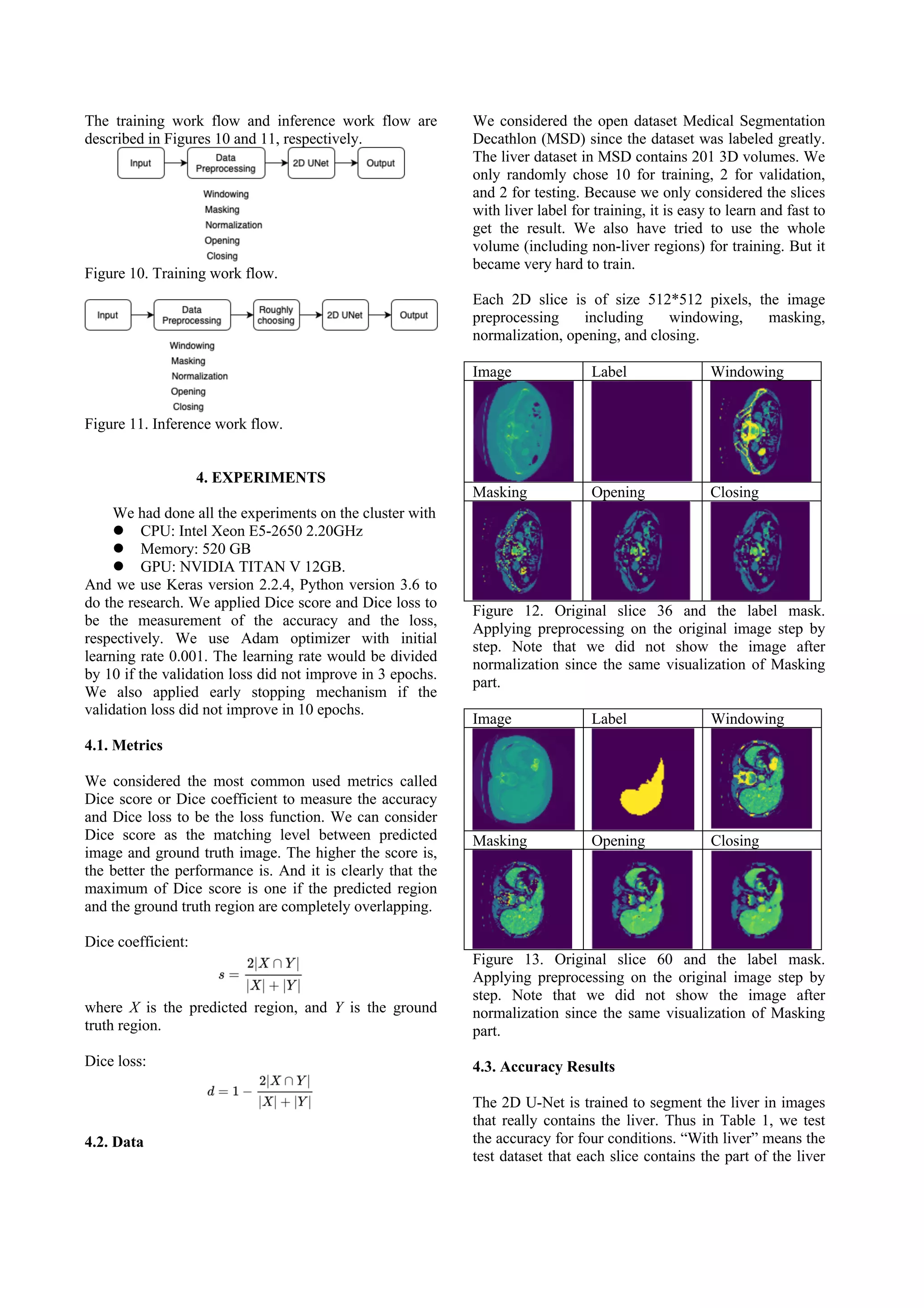
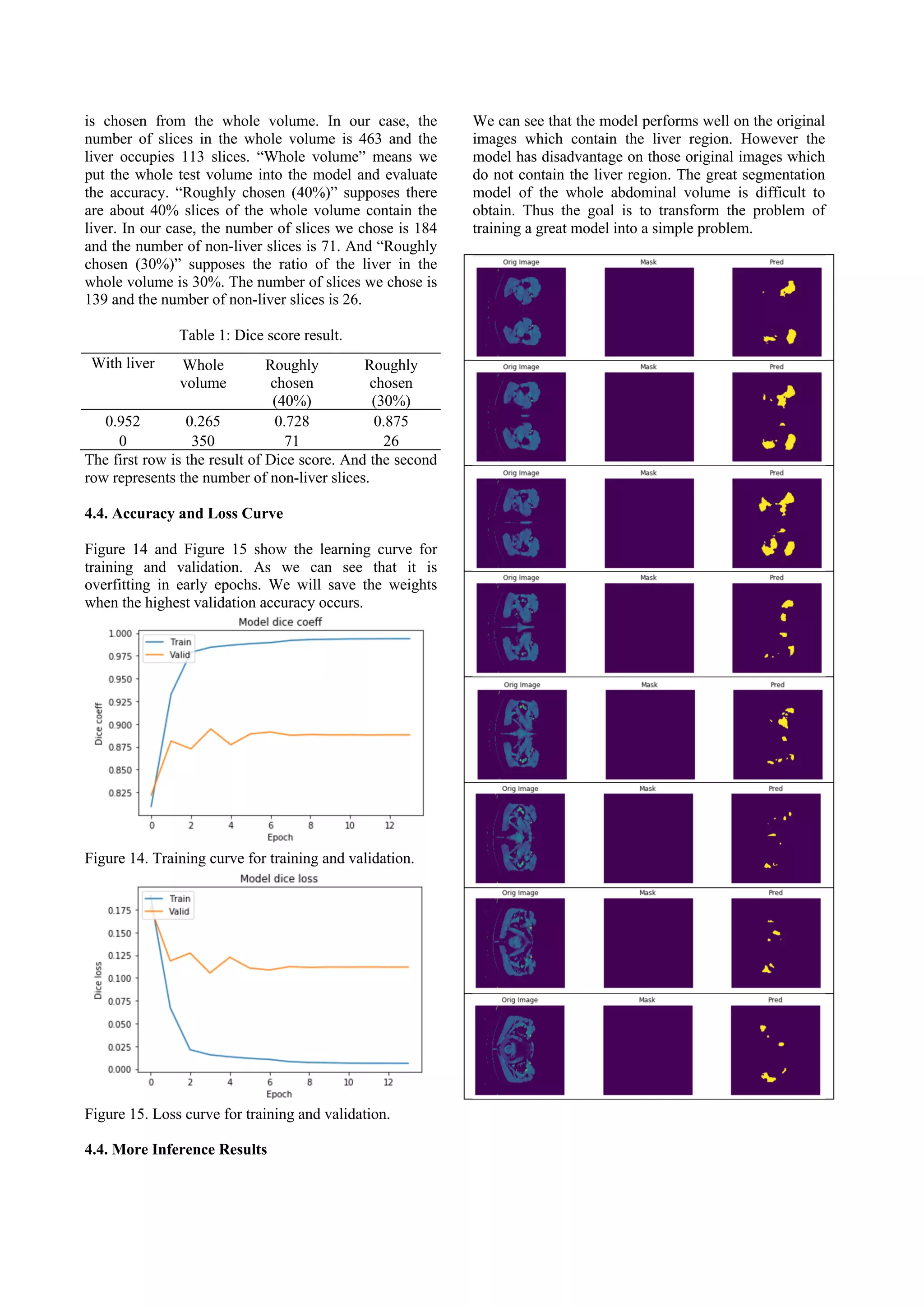
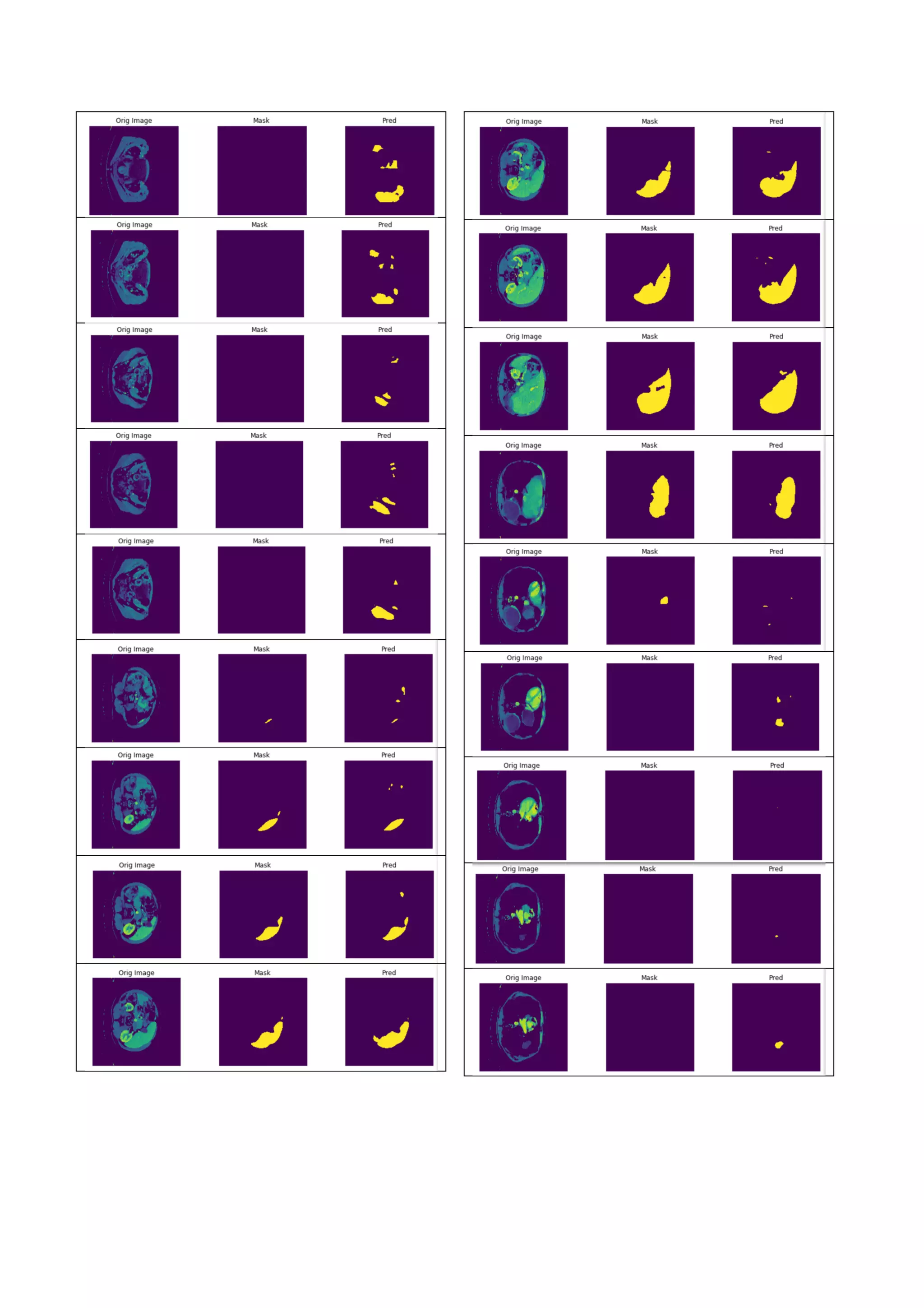
![Figure 16. Compare of the predicted liver region and the
ground truth mask. Each row represents different slice.
The left column shows the original image. The middle
column shows the ground truth mask. And the right
column shows the predicted liver region.
5. DISCUSSION
It seems that the roughly liver choosing method can help
to improve the accuracy. But it is still not good enough,
the roughly chosen (40%) contains 113 slices with liver
and also 71 slices without liver. In the other testing, the
roughly chosen (30%) contains 113 slices with liver and
also 26 slices without liver. The performance improves
significantly. So how to precisely get the range of slices
that contains liver becomes an important issue. For now,
we can find out the slice that contains the largest liver.
But we have not found some better methods based on
statistic or computer vision to choose the slices that
contain liver.
6. CONCLUSION
We proposed an idea to let the model focus on doing
liver segmentation on the images that contain liver.
And to choose the range that probably contain the liver
of the volume before inference. The tradeoff here is that
if we include more slices, we can ensure that the region
contains the liver. But if we include fewer slices, we
might not include the complete liver. The accuracy will
fall down since the unselected slices would be
considered as no liver. To include some 3D information
and use computer vision methods may help to choose
slices more accurate.
REFERENCES
[1] P. Bilic, P. F. Christ, E. Vorontsov, G. Chlebus, H. Chen,
Q. Dou, C. W. Fu, X. Han, P. A. Heng, J. Hesser, S.
Kadoury, T. Konopczynski, M. Le, C. Li, X. Li, J. Lipkovà,
J. Lowengrub, H. Meine, J. H. Moltz, C. Pal, M. Piraud, X.
Qi, J. Qi, M. Rempfler, K. Roth, A. Schenk, A.
Sekuboyina, E. Vorontsov, P. Zhou, C. Hülsemeyer, M.
Beetz, F. Ettlinger, F. Gruen, G. Kaissis, F. Lohöfer, R.
Braren, J. Holch, F. Hofmann, W. Sommer, V. Heinemann,
C. Jacobs, G. E. H. Mamani, B. v. Ginneken, G. Chartrand,
A. Tang, M. Drozdzal, A. Ben-Cohen, E. Klang, M. M.
Amitai, . Konen, H. Greenspan, J. Moreau, A. Hostettler, .
Soler, R. Vivanti, A. Szeskin, N. Lev-Cohain, J. Sosna, L.
Joskowicz, B. H. Menze, “The Liver Tumor Segmentation
Benchmark (LiTS),” CoRR, vol.abs/1901.04056, 2019.
[2] Christ, Patrick Ferdinand and Elshaer, Mohamed Ezzeldin
A. and Ettlinger, Florian and Tatavarty, Sunil and Bickel,
Marc and Bilic, Patrick and Rempfler, Markus and
Armbruster, Marco and Hofmann, Felix and D’Anastasi,
Melvin and et al., Automatic Liver and Lesion
Segmentation in CT Using Cascaded Fully Convolutional
Neural Networks and 3D Conditional Random Fields,
Springer International Publishing, 2016.
[3] X. Li, C. Huang, F. Jia, Z. Li, C. Fang, Y. Fan, Automatic
liver segmentation using statistical prior models and free-
form deformation, in: International MICCAI Workshop on
Medical Computer Vision, Springer, 2014, pp. 181–188.
[4] L. Rusko, G. Bekes, G. Nemeth, M. Fidrich, Fully
automatic liver segmentation for contrast-enhanced ct
images, MICCAI Wshp. 3D Segmentation in the Clinic: A
Grand Challenge 2 (7).
[5] A hybrid approach for liver segmentation, in:
Proceedings of MICCAI workshop on 3D
segmentation in the clinic: a grand challenge, 2007,
pp. 151–160.
[6] O. Ronneberger, P. Fischer, T. Brox, U-net: Convolutional
networks for biomedical image segmentation, in: MICCAI,
Vol. 9351, 2015, pp. 234–241.
[7] J. H. Moltz, L. Bornemann, V. Dicken, H. Peitgen,
Segmentation of liver metastases in ct scans by adaptive
thresholding and morphological processing, in: MICCAI
workshop, Vol. 41, 2008, p. 195.
[8] D. Wong, J. Liu, Y. Fengshou, Q. Tian, W. Xiong, J. Zhou,
Y. Qi, T. Han, S. Venkatesh, S.-c. Wang, A semi-
automated method for liver tumor segmentation based on
2d region growing with knowledge- based constraints, in:
MICCAI workshop, Vol. 41, 2008, p. 159.
[9] Y. Taieb, O. Eliassaf, M. Freiman, L. Joskowicz, J. Sosna,
An iterative bayesian approach for liver analysis: tumors
validation study, in: MICCAI workshop, Vol. 41, 2008, p.
43.
[10] I. Ben-Dan, E. Shenhav, Liver tumor segmentation in ct
images using probabilistic methods, in: MICCAI
Workshop, Vol. 41, 2008, p. 43.
[11] J. Stawiaski, E. Decenciere, F. Bidault, Interactive liver
tumor segmentation using graph-cuts and watershed, in:
Workshop on 3D Segmentation in the Clinic: A Grand
Challenge II. Liver Tumor Segmentation Challenge.
MICCAI, New York, USA, 2008.](https://image.slidesharecdn.com/liversegmentationwith2dunet-211007122243/75/Liver-segmentationwith2du-net-8-2048.jpg)
